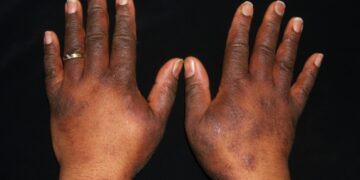March 12, 2025 Story by: Editor
Black individuals with multiple sclerosis (MS) tend to walk more slowly and cover less distance within a set time than their white counterparts, according to a U.S. study.
While the differences were somewhat reduced when researchers accounted for factors such as age, gender, physical activity, disease severity, and health insurance coverage, they remained significant.
“Our results support future research on examining mobility-focused rehabilitation modalities for improving walking performance in Black people with MS,” the study’s researchers wrote in Walking Performance is worse in Black than white people with multiple sclerosis, published in Multiple Sclerosis and Related Disorders.
MS is a disease in which the immune system attacks the myelin sheath that insulates nerve cells in the brain and spinal cord, leading to damage. This results in a variety of symptoms, including vision problems, fatigue, and difficulty walking due to balance and coordination issues.
Research suggests that Black individuals experience MS differently than white patients, with more severe symptoms and a faster rate of disability progression. Some studies have suggested that Black individuals also face greater challenges with walking, while others have found no significant differences. To clarify these findings, U.S. researchers assessed walking ability among Black and white MS patients, considering factors that could influence their mobility.
“There is limited research considering disability status when comparing Black and white people with MS on walking outcomes, yet this is important as Black people with MS have more severe disability upon initial diagnosis,” the researchers wrote.
Walking Performance Differences in Black and White MS Patients
The study analyzed initial screening data from a clinical trial (NCT03468868) that included 105 Black and 246 white MS patients. Participants completed two walking assessments:
- The Timed 25-Foot Walk (T25FW) measured how quickly patients could walk 25 feet (about 7.6 meters).
- The Six-Minute Walk (6MW) measured the total distance covered within six minutes.
On average, Black patients were 4.1 years younger than white patients (48.2 vs. 52.3 years), but they had significantly higher scores on the Extended Disability Status Scale (EDSS), indicating more severe disease progression (5.4 vs. 5.2 points).
In terms of walking ability, Black patients performed worse on both tests. They walked significantly more slowly in the T25FW test and covered a shorter distance in the 6MW test, demonstrating lower endurance.
- On the T25FW, Black patients walked at an average speed of 1.75 feet per second, which was 1.16 feet per second slower than white patients.
- On the 6MW, Black patients covered 842.3 feet, about 119 feet less than white patients (961.5 feet).
After adjusting for disease severity and other factors—including age, gender, employment status, health insurance coverage, and physical activity—these disparities slightly decreased. Black patients still walked 0.22 feet per second slower on the T25FW test and covered 82.2 feet less on the 6MW test compared to white patients.
However, the differences remained significant, indicating that these clinical and demographic factors alone could not fully explain the gap in walking performance. This aligns with prior research suggesting that Black MS patients perform worse on walking tests regardless of social determinants of health such as education and income.
“The results of this study might have value for informing future research on mobility-focused rehabilitation modalities for improving walking performance in Black people with MS,” the researchers wrote. “Indeed, rehabilitation is one of the most powerful approaches for restoring walking performance in MS.”
Source: Multiple Sclerosis News Today

















